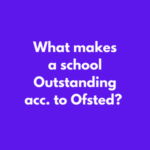
In this series of blog articles, we’ll be looking at “good” schools, according to Ofsted.
In this article, we’ll examine how much weight the Higher Standard has in achieving a “good” rating.
Key Stage 2 Greater Depth/High Score standard
Perhaps surprising, there were more indications of “good” schools not reaching the national averages than doing so. Generally, the percentage of pupils reaching the higher standard is around the National Average:
…with good proportions of pupils reaching the higher standards.
The proportion of pupils achieving the higher standard was broadly average for writing and mathematics, and above average for reading compared to national results.
…while the proportion reaching the higher standard was above that level.
The proportions of pupils achieving and exceeding the expected standards have shown a rising trend in recent years, and exceed national averages.
Ofsted can still give a school a “good” rating, even if attainment is below average.
The proportions attaining the higher standard in reading and mathematics were below average.
…not enough pupils reach the higher standard.
Pupils did not make the progress that they should towards the higher standards in relation to national figures.
However, more pupils are capable of…achieving greater depth at the end of Year 6.
…it is more typically the case in school that a below-average proportion of pupils reach the higher standard in reading and mathematics or achieve greater depth in writing. This is the case both for disadvantaged pupils and their classmates.
However, pupils are not achieving as well at greater depth and higher standards.
Too few pupils are working at greater depth in writing and in mathematics.
The number of Ofsted inspectors’ comments regarding good schools not reaching the higher standard is much greater than those regarding attainment at the expected standard. It therefore seems to play less of a factor in considering whether a school has reached a “good” rating.
Indeed, inspectors sometimes point out that a school has focused on the expected standard, and not the higher standard:
Few pupils achieve the higher standard in reading, writing and mathematics by the end of key stage 2. No pupil has attained the higher standard in a combination of all three subjects in the past three years.
The school’s focus over the past two years has been on ensuring that more pupils improve in reading, writing and mathematics. While this goal has been reached, not enough pupils are reaching the high standards and greater depth of which they are capable, particularly in mathematics.
What is missing, and what is working?
Due to this greater number of schools not reaching the higher standards, inspectors have more opportunity to reflect on what is missing:
However, there are variations in the opportunities that pupils have to apply their knowledge and skills at a greater depth, particularly in mathematics.
The headteacher recognises that more should be expected of pupils in reading, and is already putting in place strategies that aim to redress this shortfall.
However, some pupils previously assessed as middle attainers in Year 2 are not yet progressing well enough to reach higher standards in solving problems.
Leaders continue to work with staff to ensure that there are high expectations of every pupil. However, this is not yet consistently the case across the school and results in some pupils not reaching the higher standards as quickly as they might.
Pupils are making effective progress in writing, but work set leads to pupils repeating skills that are already secure and not developing the highest standards for enough pupils. It also shows that pupils’ love of reading is not being used well to develop extended writing that allows pupils to reach the highest standards in writing.
However, due to historic low expectations, there is a legacy of underachievement that has yet to be fully addressed.
This is because pupils’ progress has been limited by their historically weaker standard of spelling, punctuation and handwriting.
Is your school’s higher standard at or above National averages? If not, have you analysed the questions which your pupils answered to see where the gaps lie? Please see how our Question Level Analysis may assist you in this.
But it is not all bad news. Ofsted inspectors also highlight what is working:
Leaders have acted quickly to secure improvements in the teaching of poetry. They have provided training for teachers and ensured that pupils explore poetry more frequently and in greater depth.
Pupils are fluent in their calculations and can apply them to solve a range of problems.
Pupils are still developing their reasoning, both verbally and in writing, to achieve higher standards of attainment.
We hope that you have enjoyed this article.
This series examines the comments of Ofsted Inspectors from 80 full inspections of schools which were deemed to be “good”.
Related Articles
- Good Schools 2018 – High Prior Attaining pupils
- Requires Improvement Schools 2018 – Key Stage 2 Attainment
DAISI Education
Thank you for reading this article.
Find other Blog articles by clicking here
Check out more about how we can help your school: Primary | Secondary


